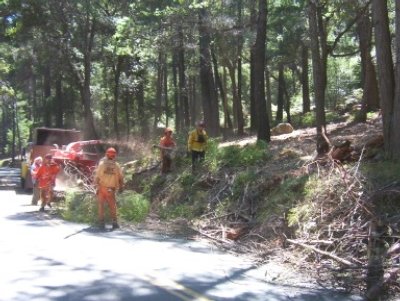- Elizabeth Larson
- Posted On
Blue Shield pulls HMO out of Lake County
LAKE COUNTY – Citing extraordinarily high health care costs, Blue Shield of California is pulling its health care plan out of Lake County, a decision expected to affect nearly 2,100 county government employees and family members.
On Tuesday, the CalPERS Board of Administration approved Blue Shield's plan to stop offering its health maintenance organization (HMO) plan in Lake and three other rural Northern California counties, according to Karen Perkins of CalPERS' Public Affairs Office.
CalPERS, based in Sacramento, is the country's third-largest provider of health benefits. It currently offers insurance and benefits to 1.2 million state and public agency employees, retirees and their dependents.
Blue Shield asked to withdraw its HMO health care product from Lake, Napa, Plumas and parts of El Dorado counties, citing health care costs 78 percent above the state average, Perkins reported.
CalPERS said it will provide other health care options to public employees in lieu of the withdrawn Blue Shield coverage.
The plan change will impact about 9,100 CalPERS members among the four counties, including 1,200 in Lake County, Perkins said.
Those affected locally are primarily state and county employees; the cities of Lakeport and Clearlake are not CalPERS subscribers, Perkins noted.
The move is expected to save $30 million in premiums, CalPERS reported.
“For years, other members [outside the four counties] have, in effect, subsidized these costs, but costs have become so high we are not able to continue this,” said George Diehr, Chair of the CalPERS Health Benefits Committee. “We are disappointed that providers in this area were not able to be responsive to the need for more affordable care.”
Blue Shield finds higher costs
Perkins said Blue Shield originally looked at 11 rural Northern California counties before settling on the four in question.
In Lake County in particular, a Blue Shield study found health care costs were 89-percent higher than the statewide average, according to CalPERS.
Blue Shield asserted that hospitals “are a key driver of health care costs,” in Lake County.
Annual hospital costs are estimated by Blue Shield to be 175 percent higher in that county – $3,923 per day, compared with $1,429 per day. Average hospital inpatient costs are 61 percent higher in Lake County – $8,325 per day, compared with the statewide average of $5,166 per day.
Representatives from Sutter Lakeside Hospital and Adventist Health's Redbud Community Hospital could not be reached for comment at midafternoon on Blue Shield's assertions.
Perkins said the study found several “common denominators” amongst the four counties in question.
“Some of the issues are that in these counties what we've found overall is that a greater percentage of the population are receiving services that are categorized as 'chronic,'” she said.
“Chronic” diseases, she said, include asthma, diabetes, congestive heart failure and kidney failure. Cancer, she added, is not among those diseases.
Along with having a population that has more chronic health conditions, the study found Lake County had higher-than-normal hospital, surgery and pharmacy costs.
From September 2006 through February 2007, Blue Shield conducted Regional Council meetings in Lake County to identify health care cost drivers and discuss ways to improve affordability in the county, CalPERS reported.
During that time, Blue Shield sought assistance from physicians and hospitals to organize them into health care delivery networks that would reduce costs and enhance delivery of care, according to CalPERS. However, Blue Shield reported their efforts met with limited success.
There is a lack of alternative health facilities, said Perkins, with more procedures that could be done on an outpatient basis having to be done in the local hospitals.
The US Census Bureau's most recent population estimate for Lake County is 65,933, of which 16.2 percent – or 10,549 people – are above the age of 65.
Could those numbers account for the the higher incidences of chronic conditions found?
Perkins said she wasn't aware if the Blue Shield study disseminated those numbers, although it was referenced in the Regional Council meetings.
“They didn't pinpoint it as being the main cause, necessarily,” she said. “They referenced it in passing.”
Kathy Ferguson, the County of Lake's personnel director, said the county worked with Blue Shield on its Regional Councils, which studied the health care costs.
As to the findings about Lake County's health care costs and unique conditions, Ferguson said, “The information they were providing seemed to be accurate.”
What the changes mean for employees
Ferguson said the Blue Shield HMO plan being eliminated is the most popular among county employees. While the choices aren't as great as in a preferred provider organization – or PPO – and there are higher premiums, there typically aren't deductibles with HMOs, she explained.
Information provided from CalPERS shows that of the more than 1,700 employees in Lake County who subscribe to CalPERS health coverage, nearly 1,200 use the Blue Shield plan.
The plan covers a total of 2,105 people, which includes the employees and their family members, CalPERS reported. Of those, about half live in and around Lakeport and Kelseyville.
The changes resulting from Blue Shield's exit will take effect Jan. 1, 2008, said Ferguson, at the start of the health plan year.
CalPERS reported its members in Lake County will continue to receive quality health care either through one of the system’s other HMO or PPO offerings.
Members also can enroll in an additional PPO plan – PERS Select – approved by the board Tuesday. PERS Select is provided at a lower cost than the standard PPO, and utilizes a smaller panel of doctors and specialists identified by Blue Cross of California as meeting certain efficiencies and patient satisfaction standards.
In addition, CalPERS reported that some members in Lake County can also take advantage of the Rural Health Care Equity Program, which would provide a subsidy of up to $1,500 per year.
Ferguson said she was waiting to receive the final information on the proposed changes to the other CalPERS health plans.
She said she's not certain how reenrollment in the other plans will happen, but in the past, when there have been plan changes, CalPERS has simply switched employees over to plans they believe will be the most popular, allowing employees to change later if they choose. That results in less of a paperwork headache for county staff.
Health care plans leaving the county isn't new, said Ferguson.
“HMOs have come and gone out of the county several times before,” she said.
E-mail Elizabeth Larson at This email address is being protected from spambots. You need JavaScript enabled to view it..
{mos_sb_discuss:2}












